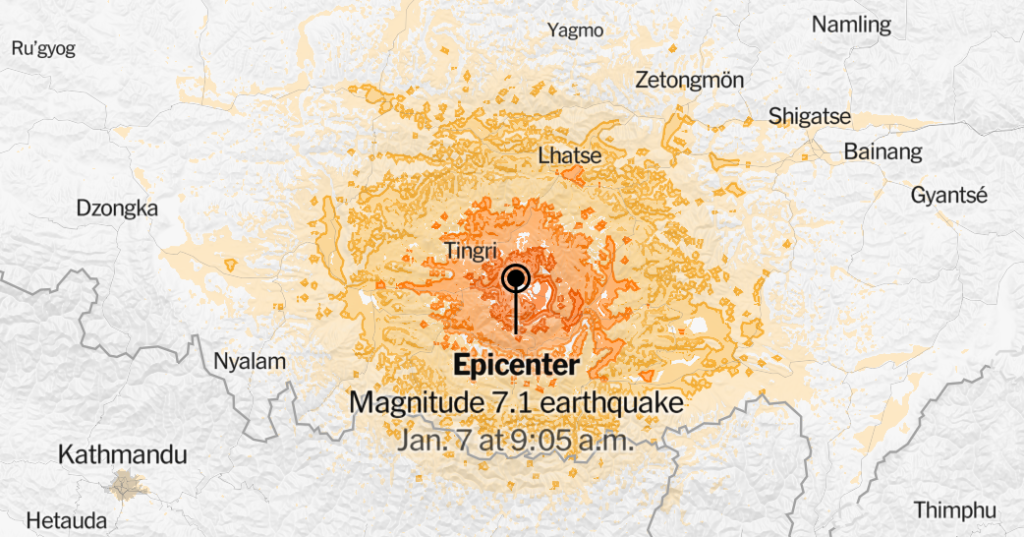Using their hands and shovels in frigid conditions, rescue workers dug through the rubble in the search for survivors after a deadly 7.1-magnitude earthquake jolted people awake in a remote part of Tibet on Tuesday near the northern foothills of Mount Everest.
At least 95 people had died and 130 were injured in the quake, which struck shortly after 9 a.m. at a depth of 6.2 miles in Dingri County, near one of Tibet’s holiest cities, in western China, state media reported. The quake in western China was the country’s deadliest since December 2023, when 151 people were killed in a 6.2-magnitude temblor in the northwestern provinces of Gansu and Qinghai.
China’s state broadcaster reported that more than 1,000 houses had collapsed in Dingri County, located along the Himalayan border with Nepal. Scenes of destruction were broadcast on state media and shared on social media.
Frantic rescue efforts were being conducted without heavy equipment, underscoring the challenge in delivering resources to the largely isolated communities damaged by the quake. With temperatures in the region dipping as low as 5 degrees Fahrenheit (minus 15 degrees Celsius), rescue workers have a short window in which to locate survivors. It was unclear how many residents had been left homeless by the quake.
Several aftershocks were felt in the area, including in Nepal. The quake had a magnitude of 7.1, according to the United States Geological Survey, though it was measured as 6.8 by the China Earthquake Networks Center.
The nearest city to the earthquake’s epicenter was Shigatse, the second-largest city in Tibet, with a population of 640,000. Shigatse is regarded as a holy site as the seat of the Panchen Lama, one of the most senior figures in Tibetan Buddhism. It was unclear if any of Shigatse’s centuries-old monasteries were damaged.
Tibet remains one of the most inaccessible and underdeveloped parts of China. Security has been heightened for decades because of tensions between Beijing and Tibetans, many of whom have long struggled to maintain their religious freedom and cultural identity in a country dominated by Han Chinese. Foreign journalists are forbidden from traveling independently in the region.
A tourist not far from Shigatse who spoke to The New York Times said she was in her hotel room when the earthquake started shaking her building. She said the electricity went out and that she and a friend squatted between the beds. When the shaking stopped, they ran out of the building.
The tourist, who only gave her surname, Xu, shared a video showing several single-story brick buildings with collapsed walls. Video posted on Chinese social media showed streets strewed with rubble, cars crushed by fallen bricks, and roads split open by the shifted ground. Ms. Xu said that she grabbed her down jacket before she ran out.
China’s top leader, Xi Jinping, ordered officials to minimize casualties and resettle survivors. The Chinese authorities deployed 1,500 rescuers and more than 250 vehicles for the search effort.
The Himalayan region is prone to powerful earthquakes. In 2015, a quake in Nepal with a magnitude of 7.8 killed nearly 9,000 people. In Kathmandu, Nepal’s capital, residents streamed out of their homes in the morning as the earthquake rattled buildings.
At least two people, one in Kathmandu and another one in Sindhupalchowk, a district north of Kathmandu, sustained minor injuries from the quake, according to Nepalese police.
Nepal sent more than 2,500 police officers to assess damage and look for victims.
“Based on the magnitude of the earthquake, there could be some damage in mountains of eastern Nepal,” said Lok Bijaya Adhikari, a senior seismologist at Nepal’s National Earthquake Monitoring and Research Center.
Most residents from Nepal’s high mountain regions such as Everest, Makalu, Rolwaling and Kanchenjunga have migrated to lowland areas to avoid the extreme cold of winter.
“Although most people migrate to lower land during winter season, some are still there,” said Ang Tshering Sherpa, the former chief of the Nepal Mountaineering Association. “There’s always risk of avalanche and glacial lake outburst floods after earthquakes.”


